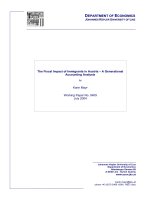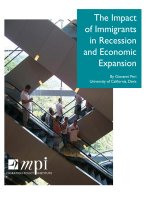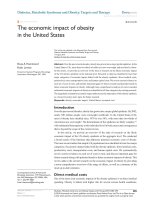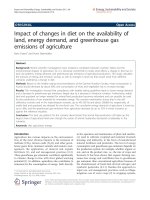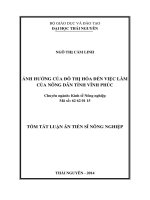Impact of Krishi Bhagya Yojana on cropping pattern and irrigation practices of farmers in Kalyana Karnataka region
Bạn đang xem bản rút gọn của tài liệu. Xem và tải ngay bản đầy đủ của tài liệu tại đây (251.47 KB, 6 trang )
Int.J.Curr.Microbiol.App.Sci (2020) 9(7): 2561-2566
International Journal of Current Microbiology and Applied Sciences
ISSN: 2319-7706 Volume 9 Number 7 (2020)
Journal homepage:
Original Research Article
/>
Impact of Krishi Bhagya Yojana on Cropping Pattern and Irrigation
Practices of Farmers in Kalyana Karnataka Region
M. Thimmesha, Jagrati B. Deshmanya* and K. Suresh
Department of Agricultural Economics, University of agricultural Sciences,
Raichur, Karnataka, India
*Corresponding author
ABSTRACT
Keywords
Cropping pattern,
Impact, Irrigation,
Ssocial participation
Article Info
Accepted:
22 June 2020
Available Online:
10 July 2020
The present paper explains the impact of Krishibhagya Yojana on social
participation, cropping pattern and irrigation practices of farmers in the
North Eastern Karnataka. For the study primary data were collected from
75 beneficiaries of farm pond scheme (Krishibhagya Yojana) and 75 nonbeneficiaries through pre-tested questionnaire. The findings of the study
reveals that after implementation of KBY the cropping intensity was
increased from 103.33 to 121.66 per per (17.73 %). There was a substantial
increase in area under irrigation farming after the implementation of Krishi
Bhagya Yojana in the study area.
Introduction
Karnataka state is agricultural based state,
having 70 per cent of cultivable land under
dry land condition. The dry land area
contributes 55 per cent of food grains and 75
per cent of oilseed production to the overall
agricultural production of the Karnataka state.
Karnataka state has 10 agro-climatic zones,
out of which five are dry zones, farmers in
dry land areas are small and marginal farmers
facing more uncertain climatic situation. In
addition, effect of climate change seen in the
form of long dry spells and heavy rains in rain
fed areas, it caused severe drought and floods
in the state. Therefore, rainfed areas that to in
those low rainfall receiving agro-climatic
zones need a suitable agricultural policy to
achieve sustainability in dry land agriculture
in the state by providing assured irrigation
facilities to the farmers. To unlock the
potential of rainfed agriculture, the
Government of Karnataka has launched
flagship scheme to achieve revolutionary
change
in Karnataka’s
farm
sector
named ‘Krishi Bhagya Scheme’ on September
2014. Under this scheme, government is
committed to transform agricultural sector
by increasing farm productivity through
infusion of new technology and equipments,
sustainable agricultural practices, efficient use
of water and irrigation facilities in the state. In
2561
Int.J.Curr.Microbiol.App.Sci (2020) 9(7): 2561-2566
2016, the Government of Karnataka extended
this scheme to all the zones of Karnataka
state. The present study was undertaken to
analyse the impact of Krishi Bhagya Yojana
scheme on cropping pattern and irrigation
practices of farmers in the study area.
Materials and Methods
A multi stage random sampling method was
adopted for the selection of sample farmers.
In the first stage, Bidar, Kalaburgi and Yadgir
district were selected as the study area, which
was covered during the first phase of the
Krishi Bhagya Yojana (KBY). In the second
phase, among the selected district, all the
taluks i.e. Bidar, Basavakalyan, Humnabad,
Aurad, Bhalki in the Bidar districts, Yadgir,
Surapur and Shahpur in the Yadgir district
and Kalaburgi, Chitapur, Aland, Jevargi,
Chincholi, Afzalpur and Sedam in the
Kalaburgi district were selected. Again
among the selected taluks, one Raitha
Samparka Kendra (RSK) was selected
randomly. Again among the selected RSK’s,
four Krishi Honda beneficiaries and one
shade net/ polyhouse beneficiary were
selected randomly. So that each taluk having
5 beneficiary farmers and 5 non-beneficiary
farmers are selected. The total sample size
was 150, out of which 75 were beneficiaries
and 75 were non-beneficiaries in the study
area.
Both primary and secondary data were
collected for the study. The secondary data
pertains to the list of the beneficiaries of KBY
from Department of Agriculture of different
taluks in the study area. The primary data
related to the agriculture year 2017-18 was
elicited using pre-tested structured schedules.
Tabular analysis was employed including
percentages and averages in respect of socioeconomic features of sample farmers,
cropping system and irrigation practices.
Results and Discussion
Distribution of sample farmers according
to their social participation
The social participation of beneficiaries and
non-beneficiaries of KBY are presented in
table 1. It was seen that majority of the
beneficiary farmers (73.06 %) are not
participated in the social organizations.
While, 15.46 per cent of farmers regularly
participated in social organizations and 14.13
per cent had occasionally participated (fig. 1)
in the social organizations. Among nonbeneficiaries, majority of the farmers (92.80
%) participated in social organization (fig. 2).
While 3.73 per cent of farmers participated
regularly and occasionally in the social
organizations. In both, beneficiaries and nonbeneficiaries the social participation was high
in co-operative societies. The social
participation of beneficiaries of KBY was
significantly high in comparison with the nonbeneficiaries
Impact of KBY on cropping system among
the beneficiaries
Change in cropping system of the respondents
gives a picture of the change in area under
different
crops
before
and
after
implementation of KBY. Change in cropping
system in terms of area under crop was
compared before and after the implementation
of KBY.
The results presented in the table 2 depicts
that percentage area under sugarcane
increased from 41.80 to 41.93 per cent after
implementation of KBY and tur decreased
from 18.72 to 16.77, soyabean increased from
16.05 to 17.41 per cent, cotton increased from
15.05 to 15.48 per cent and paddy increased
from 3.67 to 3.87 per cent. Where as in the
inter cropping system, the area was decreased
to 14.25 per cent.
2562
Int.J.Curr.Microbiol.App.Sci (2020) 9(7): 2561-2566
Table.1 Distribution of samples according to social participation in the study area
Sl. No.
Particulars
1.
Village Panchayat
2.
Co-operative society
3.
Youth club
4.
Farmers forum
Total
Percentage share (%)
Regularly
00
(00.00)
24
(32.00)
20
(26.66)
14
(18.66)
58
15.46
Beneficiaries (n= 75)
Occasionally
01
(1.33)
20
(26.66)
12
(16.00)
10
(13.34)
53
14.13
Never
74
(98.66)
31
(41.34)
43
(57.34)
51
(68.00)
274
73.06
Non-beneficiaries (n=75)
Occasionally
00
(00.00)
07
(9.34)
01
(1.34)
06
(8.00)
14
3.73
Regularly
00
(00.00)
07
(9,34)
02
(2.66)
04
(5.33)
13
3.73
Table.2 Impact of KBY on cropping system among the beneficiaries
SI. No.
1
Cropping system
Before (2013-14)
Area (Acre)
(%)
Mono cropping
a. Sugarcane
b. Tur
c. Soyabean
d. Cotton
e. Sorghum
f. Maize
g. Paddy
Total
2
3
Inter Cropping
a. Tur+ Soyabean
Sequence cropping
a. Groundnut
b. Chickpea
Total
Cropping intensity (%)
Note: * indicates significant at 5 % level
After (2016-17)
Area(Acre)
(%)
% change
125
56
48
45
7
7
11
299
41.80
18.72
16.05
15.05
2.34
2.34
3.67
100
130
52
54
48
7
7
12
310
41.93
16.77
17.41
15.48
2.25
2.25
3.87
100
4.00
-7.14
12.5
6.66*
0
0
9.09
3.67
77
100
66
100
-14.25
11
4
15
73.30
26.70
100
12
4
16
75.00
25.00
100
8.33
0
17.73
103.33
2563
121.66
Never
75
(100)
61
(81.32)
72
(96.00)
65
(86.67)
348
92.8
Int.J.Curr.Microbiol.App.Sci (2020) 9(7): 2561-2566
Table.3 Impact of KBY on irrigation practices
SI.
No.
1
2
Crop
Before (2013-14)
After (2016-17)
Total
Area
(acre)
Rainfed
area
( acre)
Irrigated area
(acre)
Total
Area
(acre)
Rainfed
area
(acre)
Sprinkler
Furrow
irrigation
Sugarcane
125
-
-
125
130
Tur
56
24
32
-
Soyabean
48
12
36
Cotton
45
45
Sorghum
7
Maize
% Change
Irrigation area
(acre)
sprinkler
Furrow
irrigation
-
-
130
52
-
40
-
54
-
-
-
48
2
-
5
7
3
-
Tur + Soyabean
77
37
Paddy
11
Sub-total
376
Rainfed
area
(acre)
Irrigation area
(acre)
Sprinkler
Furrow
Irrigation
-
-
04
12
-100
25.00
-
54
-
-100
50.00
-
18
-
30
-60
-
-
7
-
-
7
-100
-
40.00
4
7
-
7
-100
-
75.00
40
-
66
-
45
21
-100
12.50
-
-
-
11
12
-
-
12
-
-
9.09
123
108
145
376
18
139
219
-85.36
28.70
51.03
-
-
-
Kharif
Rabi
Groundnut
11
5
-
6
12
4
-
8
-20
-
33.00
Chickpea
4
4
-
-
4
-
-
4
-100
-
-
Sub-total
15
9
-
6
16
4
12
-55
Total
391
132
108
151
392
22
231
-83.33
2564
139
100.00
28.70
52.98
Int.J.Curr.Microbiol.App.Sci (2020) 9(7): 2561-2566
Fig.1 Distribution of beneficiaries according to social participation
Fig.2 Distribution of non-beneficiaries according to social participation
Similarly, the crop sequence paddy followed
by groundnut increased from 73.30 per cent to
75.00 per cent and sorghum followed by
chickpea was not changed in area. Hence the
per cent change in the area of sugarcane,
soyabean, cotton, paddy and groundnut after
KBY was 4, 12.5, 6.66, 9.09 and 8.33 per cent
respectively. The cropping intensity was
increased from 103.33 to 121.66 per cent after
implementation of KBY. The per cent change
in cropping intensity after implementation of
KBY was 17.73 per cent. The similar results
can be seen in Ashturkar (1986) made a study
on ‘Progress and prospects of irrigation water
management in Maharashtra’ and reported
that jowar, bajra, paddy and cotton based
cropping systems were equally profitable
compared to sugarcane. Similar findings also
found in Patil (2012) and Chavi and Shinde
(2017).
Impact of KBY on the irrigation practice
among the beneficiaries
The practice of usage of farm pond as a
source of protective irrigation for cultivation
of crops is presented in the table 3. It was
observed from table 3 that there was
considerable difference in the area under
sugarcane before (125 acre) and after (130
acre) the implementation of the KBY. In
general, all farmers having Krishi Honda used
to provide 5 to 6 irrigations in the month of
March and April at the harvesting stage of
2565
Int.J.Curr.Microbiol.App.Sci (2020) 9(7): 2561-2566
sugarcane crop through furrow irrigation.
After construction of Krishi Honda, due to
increase in the water availability to the farms
and it leads to increased area in sugarcane
production.
It is noticed that area under tur, soyabean,
cotton, sorghum cultivation increased due to
construction of Krishi Honda (farm pond). In
general, all tur, soyabean, cotton, sorghum
cultivating farmers after the construction of
Krishi Honda, water used as protective
irrigation when there was no rains for longer
period (more than 40 days), so that area was
lower before KBY as compared to the after
KBY. While Groundnut and chickpea
Cultivating farmers used Krishi Honda water
during the rabi/summer whenever there was a
need for the critical stages of the crop growth.
Some farmers before implementation of
KBY, followed sprinkler method of irrigation
to the crops includes tur, soyabean. Whereas
after the implementation of KBY, farmers
followed furrow method of irrigation due to
availability of water in the Krishi Honda. The
irrigated area of sugarcane extended from 125
to 130 acre by practicing furrow method of
irrigation and also some of the crops used
both sprinkler and furrow irrigation such as
out of 56 acre of tur, 32 acre were sprinkler
before
KBY,
whereas
after
the
implementation of KBY the area extended up
to 40 acre of sprinkler and 12 acre of furrow
irrigation.
sprinkler irrigation and furrow irrigation was
28.70 and 51.03. Where as in Rabi season, the
percentage change in irrigation area of
groundnut was 33.00 per cent and for
chickpea, the area of chickpea brought under
furrow irrigation was about 4 acre after
implementation of KBY. It was noticed that
there was a positive impact on dryland crops
which decreased about 83.33 per cent of
rainfed area after the implementation of KBY
because of increased in area under irrigation.
Before KBY, there was no irrigation to the
crops in some part of area, whereas after the
implementation of KBY, full area of sorghum
and maize crops were covered with irrigation
using farm pond water.
References
Ashturkar, B.W., 1986, Progress and
Prospects
of
Irrigation
Water
Management in Maharashtra, Indian
Journal of Agriculture Economics, 41:
523-528.
Chavai, A.M. and Shinde, S.B. 2017, Socioeconomic impact of farm pond in
enhancing the livelihood of farming
community of Maharashtra, Agriculture
Update, 12 (3): 437-442
Patil, R.B., 2012, Impact at Water Percolation
Tank on Changing Cropping Pattern; A
Case Study of Rampur Village, Tal Jatt,
Dis: Sangali (Maharashtra)”, Online
Interdisciplinary Research Journal,
3(6):94-99.
In Kharif, the total percentage change in the
How to cite this article:
Thimmesha, M., Jagrati B. Deshmanya and Suresh, K. 2020. Impact of Krishi Bhagya Yojana
on Cropping Pattern and Irrigation Practices of Farmers in Kalyana Karnataka Region.
Int.J.Curr.Microbiol.App.Sci. 9(07): 2561-2566. doi: />
2566
